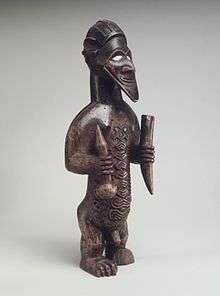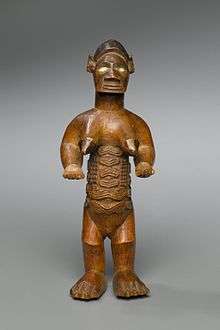Bembe people
| Regions with significant populations | |
|---|---|
| Democratic Republic of the Congo | 252,000 (1991)[1] |
| Tanzania | 360,000 |
| Republic of the Congo | 50,000 |
| Languages | |
| Bembe language, Swahili. Lingala, English, French | |
| Religion | |
| Christianity, Islam, Malkia Waubembe | |


The Bembe are an ethnic and linguistic group based in the eastern Democratic Republic of the Congo and western Tanzania. In 1991 the Bembe population of the DRC was estimated to number 252,000, with no estimate available for the number of Bembe in Tanzania[1]
Location and demography
The Bembe (Babembe, Beembe, Cuabembe, Wabembe) originate from northeast of the Democratic Republic of the Congo and western Tanzania. They are representative of numerous ethnic traditions including Lega, pre-Lega, Boyo-Kunda, and Bemba. They are a tough and proud people who absorbed other populations and their systems of thought in the process of carving out their current homeland in a time of widespread conflict and under economic pressure from European invaders and slave traders during the 19th century.
The Bembe in Congo-Brazzaville number 60 to 80,000, mostly living on the plateaus situated to the north of the Congo River, as well as on the shores of Stanley Pool and in the cities of Brazzaville, Dolisie, and Pointe-Noire. The Bembe traditionally had close contacts with their neighbors the Teke, but influence from the Kongo Kingdom was essential to their culture and traditions. In Tanzania, some of the Bembe people have become a part of Manyema, and Swahili people due to culture and language loss. Originally natives of Kigoma region, the Bembe people of Tanzania have stretched throughout the country from their home land of Kigoma to the island of Zanzibar.
Cultural traditions
Their social organisation was based on the matrimonial clan, whose members could live in several villages. The family unit generally included three generations. The chief in charge of the village, the nga-bula, mediated with the ancestors.
Hunting was the main activity; before leaving on a hunt, the leader would invoke the ancestral spirits, using as intermediaries statuettes kneeling in the position of a hunter waiting for his prey. The Bembe believed in a creator god, Nzambi, whom they did not depict figuratively. He was the master of the life and death – unless the latter was due to the act of a sorcerer, ndoki, who could magically “eat” the life force of clan members. The ancestors had close ties with the living and received offerings through the “priest” who made appeals to statuettes, the kitebi or bimbi, consecrated by the sorcerer. These figurines were the idealized images of the ancestors and would often wear attributes that allowed them to be identified as medicine men or hunters. The ancestor worship among the Bembe is older, though, and precedes the use of magic statues, nkisi, by the sorcerers.
The Bembe people of Tanzania have lost their culture for the most part, and the Bembe language is slowly fading. Most of the youth under the age of 30 are unable to speak their mother tongue; instead, they use Swahili as their first language and follow Swahili culture and traditions.
Bimbi figures
In terms of artistic practice, the Beembe have much in common with other Kongo groups, such as the use of nkisi figures. However, Bimbi figures are the most distinctive form of Beembe sculpture. Bimbi are meticulously carved ancestral figures rendered in idealized form. They display extensive geometric incisions representing scarification on their abdomens, and their eyes are inlaid with ceramic or shell shards. Bimbi typically have a small cavity between their legs, into which medicinal substances were inserted; this practice endowed the figures with protective powers. [2]
The figure usually is upright with knees slightly bent, its large feet with carefully articulated toes standing on the base; the seated position occurs less frequently. Female statuettes have a pronounced, almost square, chin, a large nose and mouth, finely sculpted ears, and hair carved in relief on the forehead. The hands of male sculptures’ are typically turned toward one another and are carrying implements that represent the ancestor's profession in life.
See also
References
- 1 2 Bembe, ethnologue.com.
- ↑ Siegmann, William C. (2009). African art a century at the Brooklyn Museum. Brooklyn, NY: Brooklyn Museum. ISBN 9780872731639.
External links
- "TRIBAL AFRICAN ART: BEMBE (BABEMBE, BEEMBE, CUABEMBE, WABEMBE)". Zyama.com. Retrieved 2011-12-18.